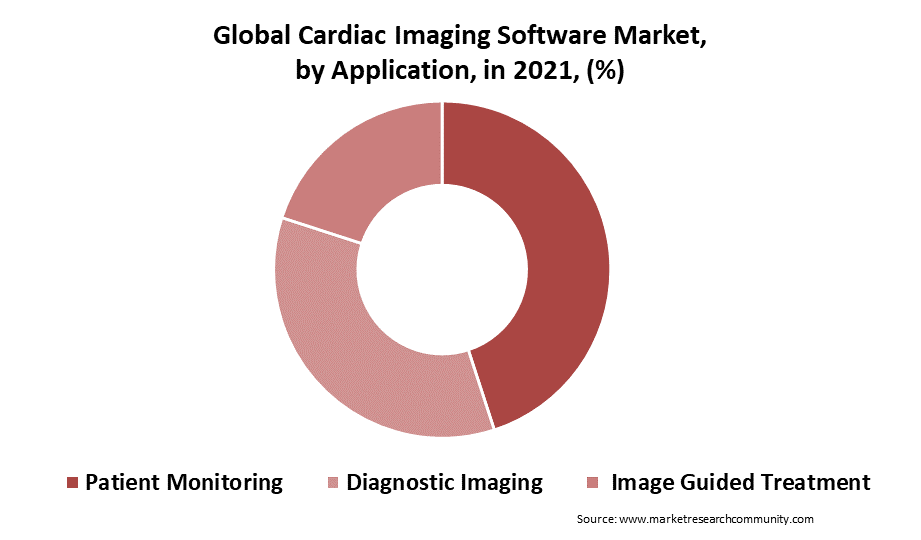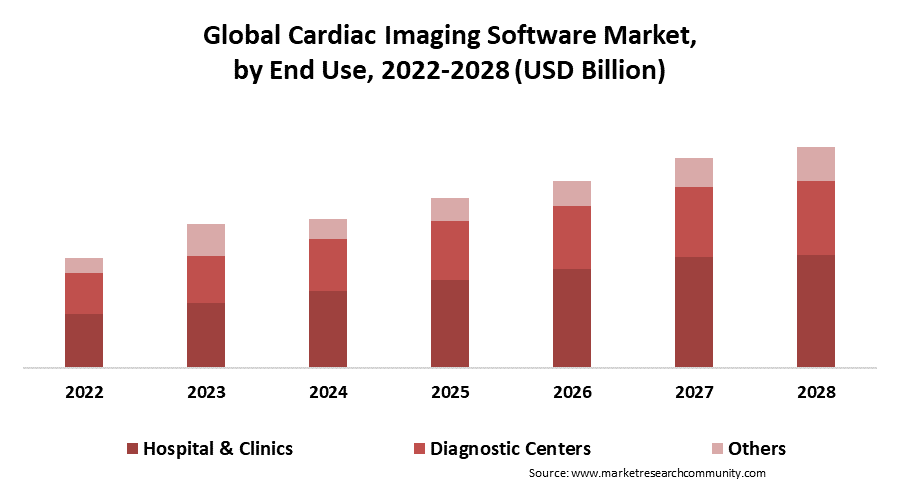Cardiac Imaging Software Market :
Cardiac Imaging Software Market is projected to be worth USD 860 Million by 2032, registering a CAGR of 8.4% CAGR during the forecast period (2024-2032), the market was valued at USD 398.72 Million in 2024. The computed tomography sector is expected to grow at a healthy rate over the projected period. As it is more effective than traditional X-rays at delivering doses of cancer-damaging radiation. The global market for cardiac imaging software is dominated by hospitals and clinics in terms of end users. This share is mostly caused by a rise in the number of people undergoing heart condition monitoring. In the regional segment, North America is expected to lead the growth of the market owing to increasing cardiovascular illness and a growing aging population.
Cardiac Imaging Software Market Dynamics:
Cardiac imaging software is used to diagnose problems with the heart utilizing CT scans, MRIs, and angiography. Medical professionals can take photographs of the heart, blood arteries, and surrounding anatomy using cardiac imaging. It displays the blood flow around and to your heart. Cardiac imaging tests can help your provider diagnose and manage heart conditions
Driver:
Cardiovascular diseases (CVD), the growing elderly population, and expenditure for cardiovascular diseases are the leading factors driving the growth of the cardiac imaging software market. Cardiovascular imaging tests are required for a physician to identify heart conditions and treat any forming cardiac disease. Further, the rise in underlying causes of cardiovascular diseases is fueling the growth of the market.
Opportunity:
Increasing mergers and acquisitions in the cardiac imaging software market are expected to create profitable opportunities for the market. For instance, TeraRecon, one of the leading companies in healthcare imaging AI technologies, was acquired by Symphony Innovation, LLC in March 2024. (US). With this acquisition, Symphony AI Group has launched a new line of healthcare AI solutions focused on medical imaging.
COVID-19 Analysis of Cardiac Imaging Software Market:
The cardiac imaging software market has been severely impacted since the COVID-19 epidemic in many different parts of the world. Shipments were impacted during the initial lockdown due to a labor shortage and the closure of a manufacturing facility. The pandemic’s initial effects on China were tremendous. However, the nation’s circumstances have stabilized, and all product and service production rates have increased. During the pandemic, many surgeries were postponed to avoid the risk of the transfer of the virus. As a result, it is determined that COVID-19’s overall impact on the cardiac imaging software market is severe.
Cardiac Imaging Software Market Report Coverage:
| Report Attributes | Report Details |
| Study Timeline | 2019-2032 |
| Market Size in 2032 (USD Million) | 860 |
| CAGR (2024-2032) | 8.4% |
| By Imaging Modalities | Computed Tomography, Magnetic Resonance, Ultrasound Imaging, X-Ray Imaging, Combined Modalities |
| By Application | Diagnostic Imaging, Image Guided Treatment, Patient Monitoring |
| By End-User | Hospital & Clinics, Diagnostic Centers, Others |
| By geography | North America– (U.S., Canada, Mexico
Europe- (Germany, France, U.K., Russia, Italy, Spain, BENELUX, Rest of Europe) Asia Pacific- (China, Japan, India, South Korea, Australia, ASEAN, Rest of Asia Pacific) Latin America- (Brazil, Argentina, Chile, Rest of Latin America) The Middle East and Africa- (GCC, Turkey, Israel, Rest of MEA) |
| Key Players | Shimadzu Corporation, Koninklijke Philips NV, Siemens AG, Canon Inc., Agfa-Gevaert Group, General Electric, Circle Cardiovascular, Fujifilm Holdings Corporation, Symphony Innovation, LLC, and Pie Medical Imaging. |
Cardiac Imaging Software Market Segment Analysis:
By Imaging Modalities
The market is divided into segments based on imaging modalities, including computed tomography, magnetic resonance imaging, ultrasound imaging, x-ray imaging, and combined modalities. The computed tomography sector is expected to grow at a healthy rate over the projected period. As it is more effective than traditional X-rays at delivering doses of cancer-damaging radiation. Further, other segments such as magnetic resonance imaging, ultrasound imaging, x-ray imaging, and combined modalities are expected to support the growth of the segment in the cardiac imaging software market during the forecast period.

By Application
By application segment, the cardiac imaging software market is divided into three sub-segments such as diagnostic imaging, image-guided treatment, and patient monitoring. The patient monitoring segment is expected to be the potential segment of the cardiac imaging software market. The factor responsible for the growth of the market is increasing awareness among consumers and rising regular health examination. Further, the high disposable income of individuals and government investment in healthiness programs is expected to support the growth of the cardiac imaging software market.
By End Use
The market is divided into Hospitals & Clinics, Diagnostic Centers, and Others based on End-User. The cardiac imaging software market has seen a huge spike in the number of individuals suffering from cardiovascular ailments such as coronary heart disease, heart attacks, strokes, congenital heart disease, and others throughout the preceding few years. The growth in the number of patients is expected to boost the expansion of hospitals globally. The global market for cardiac imaging software is dominated by hospitals and clinics in terms of end users. This share is mostly caused by a rise in the number of people undergoing heart condition monitoring.

By Region
The cardiac imaging software market is segmented into North America, Europe, Asia Pacific, and the Rest of the World based on geography. North America led the growth of the market due to the high prevalence of cardiovascular diseases, technological advancements, and high disposable income. Further, owing to aging populations, and a supportive regulatory environment, North America accounted for the majority of the global market. The dominance of North America is also related to the increase in the prevalence of heart diseases. Additionally, with the increasing advancement in technology, investment in the healthcare sector is expected to support the growth of the cardiac imaging software market during the forecast period.
Cardiac Imaging Software Market Competitive Landscape:
The competitive landscape of the market has been analyzed in the report, along with the detailed profiles of the major players operating in the industry. Further, the surge in Research and Development (R&D), product innovation, various business strategies, and Imaging Modalities launches have accelerated the growth of the Cardiac Imaging Software Market. Key players in the market include-
- Shimadzu Corporation
- Koninklijke Philips NV
- Siemens AG
- Canon Inc.
- Agfa-Gevaert Group
- General Electric
- Circle Cardiovascular
- Fujifilm Holdings Corporation
- Symphony Innovation, LLC
- Pie Medical Imaging
Recent development
- To develop AI and digital health technology for cardiology, GE Healthcare (US) and the American College of Cardiology (US) joined in June 2024.
- Circle Cardiovascular Imaging Inc. (Canada) and DiA Imaging Analysis partnered in June 2024. (Israel). Through this partnership, clients will receive comprehensive AI-based cardiovascular imaging solutions that are all-inclusive, as well as new opportunities for multi-modality imaging solutions for doctors, patients, and hospitals throughout the world. DiA’s FDA- and CE-approved LVivo Toolbox, a line of ground-breaking AI-based cardiac ultrasound solutions, will bolster Circle’s cardiac imaging portfolio.
Table of Content
- Introduction
- Market Introduction
- Market Research Methodology
- Research Process
- Primary Research
- Secondary Research
- Data Collection Technique
- Data Sources
- Market Estimation Methodology
- Limitations of the Study
- Imaging Modalities Picture of Cardiac Imaging Software
- Global Cardiac Imaging Software Market: Classification
- Geographic Scope
- Years Considered for the Study
- Research Methodology in brief
- Parent Market Overview
- Overall Cardiac Imaging Software Market Regional Demand
- Research Programs/Design
- Market Breakdown and Data Triangulation Approach
- Data Source
- Secondary Sources
- Primary Sources
- Primary Interviews
- Average primary breakdown ratio
- Market Dynamics
- Drivers
- Drivers
- Restraints
- Restraints
- Opportunity
- Impact forces on market dynamics
- Impact forces during the forecast years
- Industry Value Chain
- Upstream analysis
- Downstream analysis
- Therapeutic
- Direct Channel
- Indirect Channel
- Potential Customers
- Manufacturing/Operational Cost Analysis
- Pricing Analysis by Region
- Key Imaging Modalities Landscape
- Regulatory Analysis
- Porter’s Analysis
- Supplier Power
- Buyer Power
- Substitution Threat
- Threat from New Entry
- Competitive Rivalry
- PESTEL Analysis
- Political Factors
- Economic Factor
- Social Factors
- Technological Factor
- Environmental Factors
- Legal Factor
- Covid-19 impact on Global Economy
- Covid-19 impact on Cardiac Imaging Software Market demand
- Post-Covid Impact on Cardiac Imaging Software Market Demand
- Impact Analysis of Russia-Ukraine Conflict
- Drivers
- Global Cardiac Imaging Software Market Segmentation, Revenue (USD Million), (2022-2030)
- By Imaging Modalities
- Computed Tomography
- Magnetic Resonance
- Ultrasound Imaging
- X-Ray Imaging
- Combined Modalities
- By Application
- Diagnostic Imaging
- Image Guided Treatment
- Patient Monitoring
- By End Use
- Hospital & Clinics
- Diagnostic Centers
- Others
- By Imaging Modalities
- Global Cardiac Imaging Software Market Overview, By Region
- North America Cardiac Imaging Software Market Revenue (USD Million), by Countries, (2022-2030)
- US
- By Imaging Modalities
- By Application
- By End Use
- Canada
- Mexico
- US
- Europe Cardiac Imaging Software Market Revenue (USD Million), by Countries, (2022-2030)
- France
- UK
- Spain
- Russia
- Italy
- BENELUX
- Asia Pacific Cardiac Imaging Software Market Revenue (USD Million), by Countries, (2022-2030)
- China
- Japan
- Australia
- South Korea
- India
- ASEAN
- North America Cardiac Imaging Software Market Revenue (USD Million), by Countries, (2022-2030)
- Latin America Cardiac Imaging Software Market Revenue (USD Million), by Countries, (2022-2030)
- Brazil
- Argentina
- Chile
- Middle East and Africa Cardiac Imaging Software Market Revenue (USD Million), by Countries, (2022-2030)
- GCC
- Turkey
- South Africa
- Global Cardiac Imaging Software Market Revenue: Competitive Analysis, 2021
- Key strategies by players
- Revenue (USD Million and %), By manufacturers, 2021
- Player Positioning by Market Players, 2021
- Competitive Analysis
- Shimadzu Corporation
- Business Overview
- Business Financials (USD Million)
- Imaging Modalities Category, Source, and Specification
- Main Business/Business Overview
- Geographical Analysis
- Recent Development
- Swot Analysis
- Koninklijke Philips NV
- Siemens AG
- Canon Inc.
- Agfa-Gevaert Group
- General Electric
- Circle Cardiovascular
- Fujifilm Holdings Corporation
- Symphony Innovation, LLC
- Pie Medical Imaging
- Shimadzu Corporation
- Market Research Findings & Conclusion
Disclaimer
Research Methodology
The Market Research Community offers numerous solutions and its full addition in the research methods to be skilled at each step. We use wide-ranging resources to produce the best outcome for our customers. The achievement of a research development is completely reliant on the research methods implemented by the company. We always faithful to our clients to find opportunities by examining the global market and offering economic insights.Market Research Community are proud of our widespread coverage that encompasses the understanding of numerous major industry domains. Company offers consistency in our research report, we also offers on the part of the analysis of forecast across a range of coverage geographies and coverage. The research teams carry out primary and secondary research to carry out and design the data collection methods.
